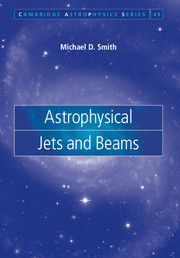Book contents
- Frontmatter
- Contents
- Preface
- 1 Introduction
- 2 Detection and measurement
- 3 The dynamical toolbox
- 4 Observations of extragalactic jets
- 5 Jets in galactic nuclei
- 6 Jets from young stars and protostars
- 7 Jets associated with evolved stars
- 8 Jets within the solar system
- 9 Jet launching
- 10 Jet propagation
- 11 The astrophysical jet
- References
- Index
10 - Jet propagation
Published online by Cambridge University Press: 05 March 2012
- Frontmatter
- Contents
- Preface
- 1 Introduction
- 2 Detection and measurement
- 3 The dynamical toolbox
- 4 Observations of extragalactic jets
- 5 Jets in galactic nuclei
- 6 Jets from young stars and protostars
- 7 Jets associated with evolved stars
- 8 Jets within the solar system
- 9 Jet launching
- 10 Jet propagation
- 11 The astrophysical jet
- References
- Index
Summary
The moment a jet has been launched and partly directed, its high thrust will vacate a channel. In an initial development stage, however, the impact region is close to the launch site. If the jet is maintained, the impact region recedes from the site using some of the jet momentum to drill the channel. A continuous supply of momentum will act to resist the ambient medium from re-entering the vacated space and so sustain a lengthening jet. Hence, the jet will become progressively longer provided the flow remains stable and fixed in direction. An early comprehensive review of the propagation physics for radio galaxies was provided by Begelman et al. (1984).
We reconsider here the conditions for a jet to remain supersonic, stable and well collimated out to large distances. We also consider the complex structures generated by dissipative and disruptive processes. A large part of our knowledge is derived from computer simulation, a method which has come a long way since the pioneering attempt by Rayburn (1977). The extensive literature necessitates a selective approach.
Components and structure
A basic description of a jet is provided by the opening angle. How the opening angle changes with distance from the source then describes the collimation properties. In theory, assuming a jet with a circular cross-section and sharp boundaries, the opening angle is well defined as 2×drs/dz, where the jet boundary is given by by rs(z) in cylindrical coordinates. This may also be termed the local opening angle. However, quoted opening angles are sometimes simply the quantity 2×rs(z)/z.
- Type
- Chapter
- Information
- Astrophysical Jets and Beams , pp. 186 - 202Publisher: Cambridge University PressPrint publication year: 2012

